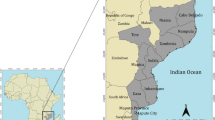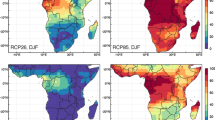Abstract
Desertification, climate variability and food security are closely linked through drought, land cover changes, and climate and biological feedbacks. In Ghana, only few studies have documented these linkages. To establish this link the study provides historical and predicted climatic changes for two drought sensitive agro-ecological zones in Ghana and further determines how these changes have influenced crop production within the two zones. This objective was attained via Markov chain and Fuzzy modelling. Results from the Markov chain model point to the fact that the Guinea savanna agro-ecological zone has experienced delayed rains from 1960 to 2008 while the Sudan savanna agro-ecological zone had slightly earlier rains for the same period. Results of Fuzzy Modelling indicate that very suitable and moderately suitable croplands for millet and sorghum production are evenly distributed within the two agro-ecological zones. For Ghana to adapt to climate change and thereby achieve food security, it is important to pursue strategies such as expansion of irrigated agricultural areas, improvement of crop water productivity in rain-fed agriculture, crop improvement and specialisation, and improvement in indigenous technology. It is also important to encourage farmers in the Sudan and Guinea Savanna zones to focus on the production of cereals and legumes (e.g. sorghum, millet and soybeans) as the edaphic and climatic factors favour these crops and will give the farmers a competitive advantage. It may be necessary to consider the development of the study area as the main production and supply source of selected cereals and legumes for the entire country in order to free lands in other regions for the production of crops highly suitable for those regions on the basis of their edaphic and climatic conditions.







Similar content being viewed by others
References
Asante A (2004) Assessment of food import and food aid against support for agricultural development: The case of Ghana; food and agriculture organization regional office Accra: Accra, Ghana
Canagarajah S, Pörtner C (2003) Evolution of poverty and welfare in Ghana in the 1990 s: achievements and challenges. World Bank, Washington
Catford J (2008) Food security, climate change and heath promotion: opening up the streams not just helping out downstream. Health Promot Int 23:105
Dietz AJ, Reuben R, Verhagen A (2004) The impact of climate change on dry lands: with a focus on West Africa. Kluwer academic, New York, pp 403–407
Dollar D, Svensson J (2000) What explains the success or failure of structural adjustment programmes? Econ J 110:894–917
Donkor AK, Bonzongo JC, Nartey VK, Adotey DK (2006) Mercury in different environmental compartments of the Pra River Basin, Ghana. Sci Total Environ 368:164–176
El-Seed AM (1987) An application of Markov chain model for wet and dry spell probabilities at Juba in southern Sudan. GeoJournal 15:420–424
Environmental Protection Agency (EPA) (2000a) National action programme to combat drought and desertification. Accra, Ghana
Environmental Protection Agency (EPA) (2000b) Ghana’s initial national communication under the United Nations Framework Convention on Climate Change, Environmental Protection Agency of Ghana, Ministry of Environment, Science and Technology, Accra, Ghana
Food and Agriculture Organization of the United Nations (FAO) (2005) Fertilizer use by crop in Ghana, Land and Plant Nutrition Management Service Land and Water Development Division,Rome
Frimpong Y, Oluwoye J, Crawford L (2003) Causes of delay and cost overruns in construction of groundwater projects in a developing countries; Ghana as a case study. In, pp. 321–326.
Gabriel KR, Neumann JA (2006) Markov chain model for daily rainfall occurrence at Tel Aviv. Q J R Meteorol Soc 88:90–95
Hulme M, Doherty R, Ngara T, New M, Lister D (2001) African climate change: 1900–2100. Clim Res 17:145–168
International Consortium for Agriculture Systems Applications (ICASA) (2009) Decision Support System for Agrotechnology Transfer, ICASA News.
IPCC (2007) climate change 2007—Impacts, adaptation and vulnerability. Contribution of working group ii to the fourth assessment report of the IPCC. Cambridge University press, Cambridge
Kottegoda NT, Natale L, Raiteri E (2004) Some considerations of periodicity and persistence in daily rainfalls. J Hydrol 296:23–37
Ministry of Food and Agriculture (2001) Agricultural census report, 1992–2000. Accra, Ghana
Ministry of Food and Agriculture (2007) Food and agriculture sector development policy (FASDEP II). Accra, Ghana
Nisar Ahamed TR, Gopal Rao K, Murthy JSR (2000) GIS-based fuzzy membership model for crop-land suitability analysis. Agric Syst 63:75–95
Ofori-Sarpong E (1980) The 1975–1977 droughts in Ghana. Hydro-meteorological aspects. Bulletin de l'Institut Fondamental d'Afrique Noire, Série A. Sci Nat 42:649–661
Ofori-Sarpong E (1986) The 1981–1983 drought in Ghana. Singap J Trop Geogr 7:108–127
Parry M, Rosenzweig C, Iglesias A, Livermore M, Fischer G (2004) Effects of climate change on global food production under SRES emissions and socio-economic scenarios. Global Environ Change 14:53–67
Sagoe R (2006) Climate change and root crop production in Ghana; Crop Research Institute: Kumasi, Ghana, pp 2–37
Sam-Amoah L, Gowing J (2001) The experience of irrigation management transfer in Ghana: a case study of Dawhenya Irrigation Scheme. Irrig Drain Syst 15:21–38
Sivakumar MVK (1988) Predicting rainy season potential from the onset of rains in southern Sahelian and Sudanian climatic zones of West Africa. Agric Forest Meteorol 42:295–305
Stern N, Treasury G (2007) The economics of climate change: the Stern review. Cambridge University Press.
Stewart JI (1985) Water requirements and water use of crops. Paper presented at the international conference on African agricultural development: Technology, Ecology, and Society; California State Polytechnic University: city, state, USA
Wang YM, Luo Y, Hua Z (2008) On the extent analysis method for fuzzy AHP and its applications. In, pp 735–748
Acknowledgments
The authors are indebted to Nature Today of Ghana for the financial support. This work has benefitted immensely from the critical comments and suggestions of two anonymous reviewers.
Author information
Authors and Affiliations
Corresponding author
Rights and permissions
About this article
Cite this article
Armah, F.A., Odoi, J.O., Yengoh, G.T. et al. Food security and climate change in drought-sensitive savanna zones of Ghana. Mitig Adapt Strateg Glob Change 16, 291–306 (2011). https://doi.org/10.1007/s11027-010-9263-9
Received:
Accepted:
Published:
Issue Date:
DOI: https://doi.org/10.1007/s11027-010-9263-9




